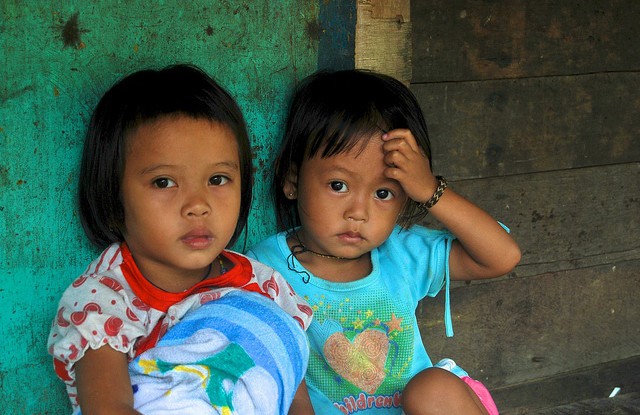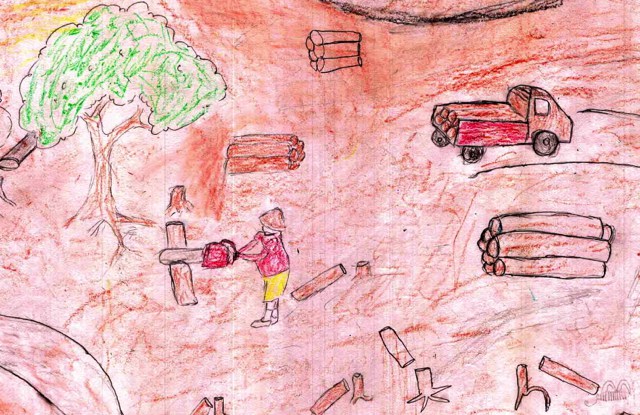A new study conducted in part by the Center for International Forestry Research (CIFOR) shows that children living in Kalimantan on the island of Borneo had a generally bleak outlook for the future of their forested landscapes.
Asked to draw the present and future of their environment, the children showed a surprising awareness of the natural functions of their surroundings. Overall, their drawings foretold a landscape largely devoid of wildlife and forested area.
Forests News recently spoke with Erik Meijaard, a CIFOR associate and a co-author of the study.
Q: From a research perspective, what significance do children’s perceptions have on resource conservation and management?
A: In applied environmental research, we want to work out how we can change the interactions between humans and their environments. In this we can focus on young, middle-aged or old people. We chose to listen to children, because they are often key societal trend-setters.
For example, people stopped smoking in many countries not because doctors told them it was unhealthy — that was known ages ago — but ultimately because increasingly young people considered it uncool to smoke.
We believe that more than older people, children are sensitive to new impressions and ideas. And because today’s children are tomorrow’s decision-makers, it is important to understand what children think now. Such understanding helps design specific messaging aimed at younger generations, which could help set new trends about how people interact with their natural environments.
Q: From a policy perspective, how can this research affect governments and decision-makers
A: Children don’t vote, so it should be easy for politicians to ignore their opinions. Still, there is significant emotional appeal to understanding what children think, and this emotional angle is harder to ignore. Global media use images of children exactly for that reason — just look at imagery of wounded children in the war in Gaza as a contemporary example. We want to use the fact that children in Kalimantan are very concerned about the state of their environment to influence political thinking.
Governments cannot keep on making top-down land-use decisions that are mostly informed by economic considerations, but ignore social and environmental impacts. And if children say that they disagree with these land-use decisions, we believe that there is good scope for influencing political thinking.
Q: Were you surprised at how aware the children were about their environment?
A: Yes, we were surprised. We had actually expected a stronger shifting baseline effect in which children would consider the present state of their environments as the “normal” condition. This did not turn out to be the case. Children in Kalimantan have a clear understanding of past, present and future trends in their environment, which matched our independent assessments of environmental change.
Also, children generally recognized the functional relationships between land cover (such as forest versus non-forest) and the provision of ecosystem services (such as flood and temperature control). Such good environmental knowledge indicates that there is a good basis for improved environmental education programs in Indonesia and improved environmental decision-making and management.
Q: Can a study like this be useful if replicated elsewhere?
A: This study could be replicated elsewhere as it uses a simple methodology that can be clearly explained to young children. Our drawing-based method is a good way for young children to express themselves freely and for capturing their perceptions. And because it was considered a fun exercise, it was also easy to get children and teachers to cooperate.
Capturing what children think about their environment in other areas would be useful, both in rural and urban environments, and we hope that other scientists will use our research elsewhere.
The study, “Through the Eyes of Children: perceptions of environmental change in Borneo,” was published in the open-access journal PLoS ONE. For more information about the topics of this research, please contact Anne-Sophie Pellier at pellier.annesophie@gmail.com; Erik Meijaard at emeijaard@gmail.com; or David Gaveau at d.gaveau@cgiar.org.
This work is part of the CGIAR Program on Forests, Trees and Agroforestry, supported by the United States Agency for International Development (USAID) Forests and Environment research program and the Arcus Foundation.
We want you to share Forests News content, which is licensed under Creative Commons Attribution-NonCommercial-ShareAlike 4.0 International (CC BY-NC-SA 4.0). This means you are free to redistribute our material for non-commercial purposes. All we ask is that you give Forests News appropriate credit and link to the original Forests News content, indicate if changes were made, and distribute your contributions under the same Creative Commons license. You must notify Forests News if you repost, reprint or reuse our materials by contacting forestsnews@cifor-icraf.org.

